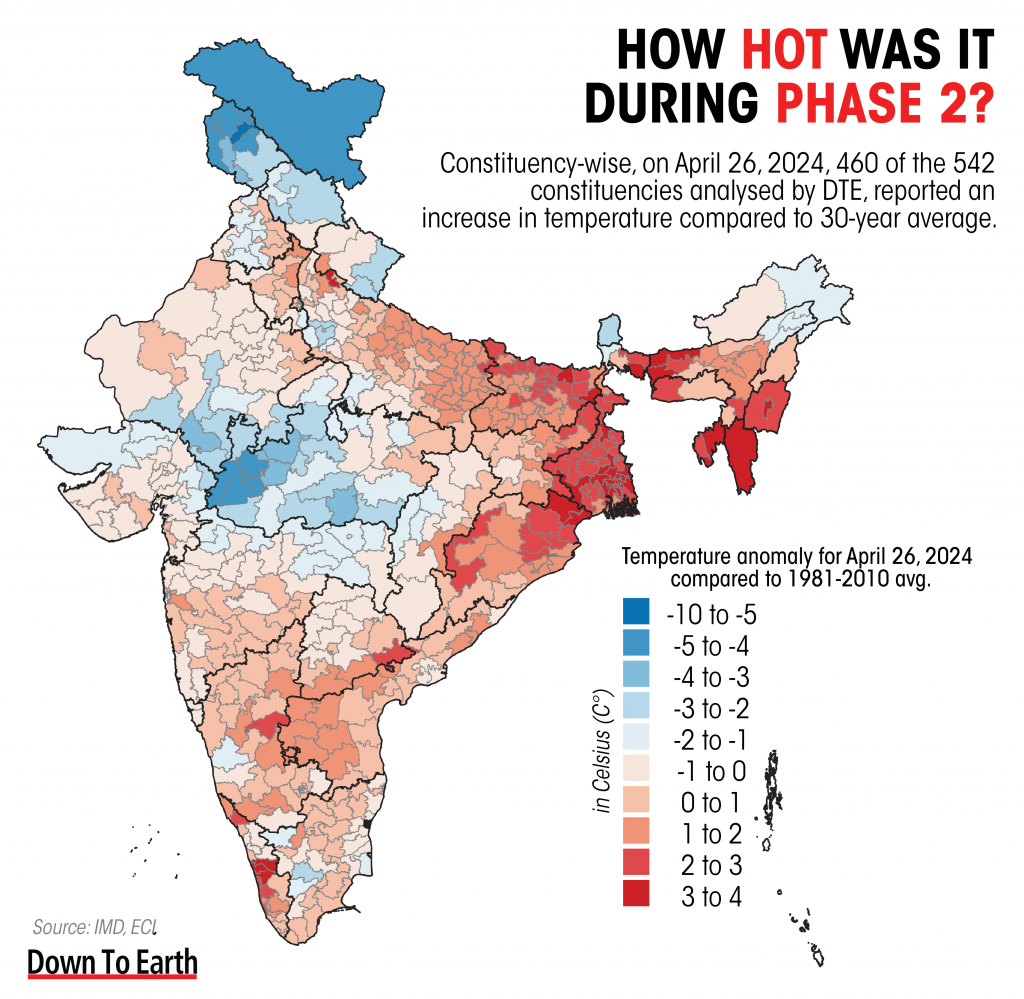DTE looks at if heat is playing any role in voter turnout this election or ECI’s heat-related concerns are unfounded

Shortly after the completion of Phase 1 of the parliamentary elections, the Election Commission of India convened a meeting with officials from the India Meteorological Department over measures aimed at protecting voters from heatwaves, which is expected to intensify as summer sets in India.
What role does rising temperature play in voter turnout in the ongoing general election 2024? While it is very difficult to qualify or quantify the degree of impact rising temperature is playing, Down To Earth (DTE) tried to add some context.
Spatial data by the India Meteorological Department suggested that of the 542 parliamentary constituencies analysed, 85 per cent or 460 constituencies have reported an increase in temperature during the second phase of the elections held on April 26, 2024, compared to the 30-year average (1981 to 2010).
Apart from the northwestern region of the country spread across Jammu and Kashmir, Himachal Pradesh, a couple of constituencies in Uttarakhand and Punjab, 23 of 29 constituencies of Madhya Pradesh also reported a dip in temperature when compared to the 30-year average.
The eastern region of the country, comprising constituencies across West Bengal, Odisha and Assam, saw the highest rise in temperature, the analysis showed.
.png?w=1000&ssl=1)
DTE also looked at the temperature with the 89 constituencies that went to poll for phase 2. The analysis did not explicitly throw up any direct correlation with rising temperatures and the inverse impact it might have had on overall voter turnout. So, any inference would be skewed.
For instance, in southern Karnataka, while most of the constituencies had reported an increase in mean temperatures that should translate to lower voter turnout, the scenario was just the opposite.
Given the inverse relation that the data threw up between temperature and voter turnout, it begs the question, is heat playing any role at all in this election or was ECI’s heat-related concerns unfounded?
While analysis of the first phase did show an inverse relationship in some constituencies, for the majority of the constituencies, DTE found a direct correlation between rise in temperature and overall decrease in voter turnout in 53 of the 89 constituencies that went to polls during the second phase.
Earlier, DTE had also reported on whether rising temperatures was a factor in influencing voter turnout during this election. During the first phase, the Indo Gangetic Plains and Rayalaseema region in the south, saw the largest increase in temperature. Surprisingly, during the first phase, constituencies in Rajasthan — Barmer, Jalore, Pali, Rajsamand and Bhilwara — had also reported a dip in temperature.
Again, that did not automatically translate into a bigger voter turnout in the region. Concurrently, DTE also found out that of the 102 constituencies which went to polls in the first phase, 87 constituencies had reported a direct correlation between rise in temperature and overall decrease in voter turnout.
We are a voice to you; you have been a support to us. Together we build journalism that is independent, credible and fearless. You can further help us by making a donation. This will mean a lot for our ability to bring you news, perspectives and analysis from the ground so that we can make change together.


















































